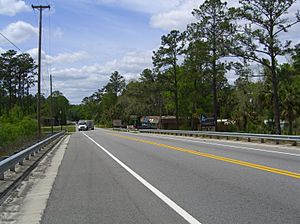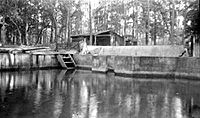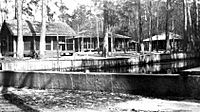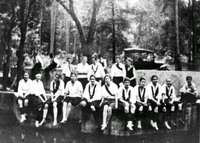Newport, Florida facts for kids
Quick facts for kids
Newport, Florida
|
|
|---|---|

Westbound US 98 as it enters Newport from the George Nesmith Bridge.
|
|
| Country | United States |
| State | Florida |
| Counties | Wakulla |
| Time zone | UTC-5 (EST) |
| • Summer (DST) | UTC-4 (EDT) |
Newport is a small community in Wakulla County, Florida. It is not an official city or town. This means it does not have its own local government. Newport is located where two important roads meet: U.S. Highway 98 and State Road 267.
Contents
Exploring Newport's Past
Early Challenges in the 1840s
In 1841, the area where Newport is now faced a tough time. A serious illness called yellow fever spread through the community. Just two years later, in 1843, a powerful hurricane hit nearby Port Leon. This storm caused a huge 10-foot storm surge, which is a wall of ocean water pushed inland. The surge washed away all the homes and buildings in Port Leon. Even today, this area can still be affected by strong hurricane surges.
Building a New Town: Newport
After the big hurricane in 1843, people needed a new place to live. A group of leaders, including Nathaniel Hamlin and James Ormond, looked for a safer spot. They found higher ground on the west side of the St. Marks River. This new location had fewer swampy areas and natural springs.
The land belonged to a company called Apalachicola Land Co. They allowed people who lost their homes in the storm to buy land plots. These plots cost $25 or more. The leaders decided to name this new settlement Newport. They planned the town with four streets running east and west. These streets were named New, Washington, Market, and Adams. The streets running north and south were called Bay, Pine, Elm, and West. These street names were very similar to those in St. Joseph, Florida, which was a large town nearby.
The Idea of a Plank Road
Newport was a port town, meaning it had a harbor for ships. It competed with another nearby port called St. Marks. St. Marks had a railroad connection to Tallahassee, which first used mules to pull train cars. Farmers and shippers would bring their cotton to these river ports. From there, the cargo would travel by ship to other ports along the coast.
People in the mid-1800s thought about building "plank roads" as a new way to move goods. These roads were made by laying wooden planks (thick boards) across the ground. This idea was much older, first used by the Spanish to build paths over wet areas. Leaders in Newport, like Ladd and Ormond, supported a plan for a plank road. This road would connect Newport to Thomasville, Georgia.
The Florida Legislature approved the Georgia and Georgia-Florida Plank Road Company in 1851. The road was not finished all the way to Georgia, but it did reach near Tallahassee. Wagons could use this road for about $1. This new road created competition for the Tallahassee Railroad. Over time, the railroad to St. Marks improved. It started using steam locomotives instead of mules. This made St. Marks the more important port. Newport became smaller, but it still exists today with a few residents.
Railroad Changes in the 1850s
In 1856, a company called the Pensacola and Georgia Railroad took control of the Tallahassee-St. Marks Railroad. They made the tracks better and replaced the mules with a steam locomotive. This change cut the travel time from five hours down to just two hours.
Natural Wonders: Newport Springs
Newport is home to Newport Springs, a special sulfur spring. Some people believe the water from this spring has healing powers. The spring's water flows into the St. Marks River. Below the springs, there are also several caves. Today, Wakulla County helps take care of Newport Springs.
Photo gallery
Nearby Places to See





